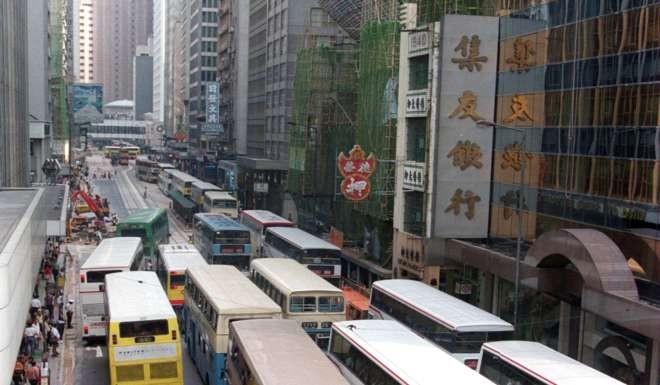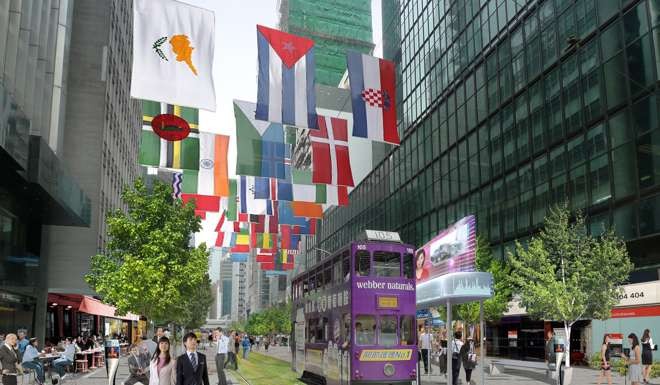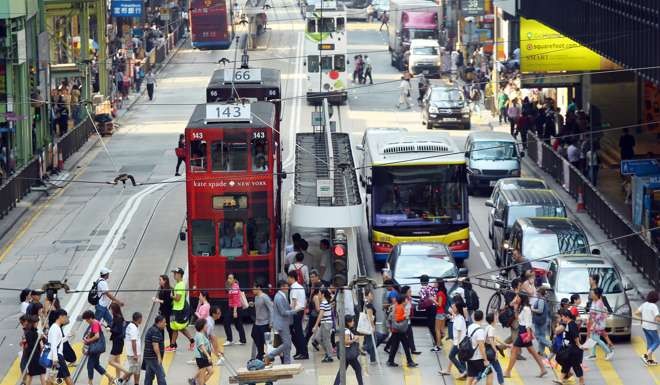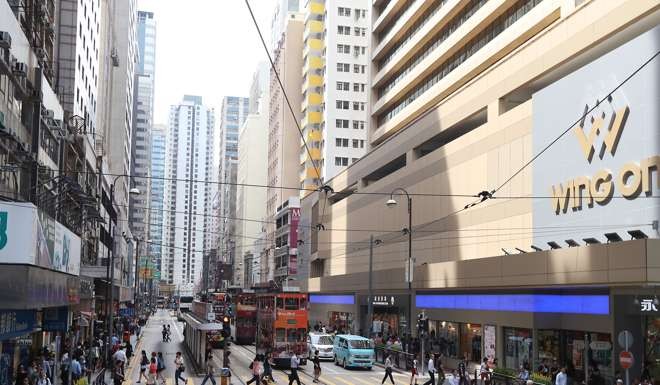
Major Hong Kong street to go car free this weekend – but city ‘lagging behind’ New York and London
Planned closure of Des Voeux Road in Central hailed as breakthrough for car-free events, but experts say it is just a “small step” towards much-needed greater pedestrianisation

Hong Kong is “lagging behind” other international cities in terms of traffic management and pedestrian-friendly roads, campaigners and academics have said.
Transport chiefs should work harder to make the city’s streets, often criticised as overcrowded, safer and more enjoyable for pedestrians and cyclists, experts suggested.
They could also learn a lot from pedestrianisation schemes in cities such as London and New York, they said.
The criticisms came ahead of a planned closure of Des Voeux Road in Central – the heart of the city’s business hub – this weekend. The road will be temporarily closed to traffic on Sunday between Pedder Street and Morrison Street, in what campaigners have hailed as a significant breakthrough for car-free events in Hong Kong.
Patrick Fung Kin-wai, chief executive and co-organiser of Clean Air Network, which is leading Sunday’s event, said it was just a “small step” towards making the city less congested and more environmentally friendly.

He said he hoped transport chiefs would begin to seriously consider proposals to make other parts of the city permanently pedestrianised while his group starts planning similar car-free days for next year.
“It is a test for the council to look at the feasibility,” he said. “From our point of view it is important for us to locate areas with other social problems. It is a long shot but we should start to look at how we can connect these zones together. It will be quite difficult, but this is a small step.”
Hong Kong currently has seven full-time pedestrian schemes, 30 part-time pedestrian schemes and more than 40 traffic calming schemes.
Some of its busiest districts, including Causeway Bay, were pedestrianised after 2000: Jardine’s Crescent, Paterson Street and Russell Street were fully pedestrianised, while Lockhart Road, East Point Road and Great George Street were made part-time pedestrian roads.
But Fung said he wanted to see stronger connections between car-free roads, particularly between the east and west of Hong Kong Island.
“We have to involve the people in the process,” he said. “People lack space in Hong Kong; when we tell people this is possible, they get really excited.”
Sunday’s event will be held just a few days after World Car Free Day was celebrated across the globe on Thursday.

In London, pedestrianisation schemes have increasingly garnered support from politicians, road users and business owners, with the city’s main shopping hub, Oxford Street, due to become car free by 2020. Meanwhile in New York, parts of Broadway, including Times Square, were subjected to a pedestrianisation experiment in May 2009 which became permanent in February 2010 and was found to have significantly improved traffic flow and pedestrian safety.
Associate Professor Alain Chiaradia, programme director master of urban design at the University of Hong Kong, said that while Hong Kong’s public transport network was very efficient, it was still “lagging behind” other international cities in terms of its provisions for pedestrians and cyclists.
He said the city was somewhat restricted by its geography, because it is surrounded by hills, but said car-free days were a step towards mobilising support for more pedestrianised areas.
“Hong Kong, for a long time, has been like the best student in the class in terms of transport, so maybe it got complacent,” he said. “It was so successful at some things so maybe they felt like they did not have to worry. I think this could be the turning point.”
Whilst environmentalists support plans for a congestion charge in Hong Kong, road users remain largely unconvinced it will solve the city’s congestion problems.

The number of cars in Hong Kong has been steadily growing since 2000. In 2015, about 500,000 private cars were registered for the city’s roads and this could rise to 540,000 by next year, according to the Environment Bureau. Whilst this figure is still significantly lower than countries such as Singapore and Taiwan, members of the Transport Advisory Committee suggested the city’s car usage should be curbed because of congestion problems.
Fung went on to suggest that as an environmental campaigner, he was keen to win over the public’s hearts and minds in the air pollution debate.
“Hong Kong is an international city but many of the situations here are not going towards that direction,” he said. “We deserve better; we deserve that kind of quality of life – like New York or London. The traffic initiatives are not that good compared to other cities in the world.
“This is a big improvement overall. We have to make this city more pedestrianised. People are always sceptical, but this may benefit them in a variety of ways, like bringing more visitors to Central.”

Defending its commitment to pedestrianisation in Hong Kong, a spokeswoman for the Transport Department said it had taken “a number of measures to enhance pedestrian facilities for encouraging walking and improving the walking environment”.
She said future plans included building a footbridge along Gloucester Road to connect the group of elevated walkways at Wan Chai North with parts of Admiralty, as well as devising schemes for several road junctions along Des Voeux Road.
“Our pedestrian facilities and schemes have improved the pedestrian mobility and the overall pedestrian environment through reduction of vehicle and pedestrian conflicts and discouraging access of non-essential traffic, “ she said. “We consider that any pedestrian-only scheme should strike a balance between the benefits brought to pedestrians and the needs of commuters using different modes of transport and the transport trades.”
Pedestrianisation: how does Hong Kong stack up?
New York
Although not common in the United States generally, pedestrian-only streets have been successful in New York, particularly around Broadway. The city has become both a national and international model for pedestrian plazas and bike lanes.
London
London’s mayor Sadiq Khan has proposed a series of measures to improve air pollution, including to make shopping hub Oxford Street car free. Transport chiefs have invested £100 million (HK$1.01 billion) in a “Mini-Hollands” scheme which will see three outer boroughs of the city transformed into cycling and pedestrian-friendly hubs.
Paris
The number of Parisians who do not own a car has fallen by about a fifth since 2001, while the mayor has announced plans to double the number of bike lanes. Traffic has been banned once a month from the avenue which leads to the Champs-Elysees. Mayor Anne Hidalgo also plans to make the right bank of the River Seine into a pedestrian-only zone.
Madrid
The centre of Madrid is set to be completely pedestrianised over the next five years, with 24 of the city’s streets being redesigned to remove car lanes. About two thirds of the street’s surface will become pedestrian-only in an attempt to reduce congestion and enhance the pedestrian experience.
Copenhagen
More than half of the city’s population cycles to work each day. Car-free zones have spread across the city since the 1960s, with car ownership ranking as one of the lowest in Europe.